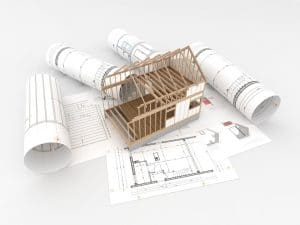Buying a House to Subdivide – Development Fundamentals
As the property investment sector matures in Australia, more and more investors are looking to small development as a way to improve their overall financial position.
There are a number of ways that investors can create wealth through property development, including subdivision.
But what are the ins and outs of buying a house to subdivide in Australia? What are the costs and the steps to subdivide property?
Well, in this article, we’ll outline all of this and much more so you have all the information you need to successfully buy a house to subdivide.
The types of subdivision

There are many different types of subdivision but not all strategies are suitable to all properties because of the various rules, regulations and zoning found in each state and territory across the country.
It’s important that you have a sound understanding of the relevant zoning and planning guidelines, however it’s also a good idea to seek advice from experts like town planners who can outline what can, and what can’t, be developed on any particular site.
So what are the different types of subdivisions?
Strata title
Involves converting a single title into multiple titles e.g. splitting up block of 10 units on one title into 10 separate titles. This increases the value of the properties and it allows you the option of selling each one off individually, which can be lucrative.
Granny flat
Not every state or territory allows for granny flat construction, nor is it suited for every market because there has to be demand from potential tenants to live in one of these dwellings to be make it financially viable. This is why it’s important to know the area you’re investing in very well. Granny flats, for example, may not be suitable for regional areas given the affordability of property generally in those areas.
Second property
This involves splitting a large block of land into two or more lots and then building a new property on the vacant land.
Raw land
This is a process that is much more involved and is very capital intensive. Developing raw land requires not only a legal splitting of the property but also physically changing the use of the land. This strategy is perhaps not one for novice small developers, unless they have plenty of expert assistance and advice.
What to look out for

Zoning
With any potential small development, as previously mentioned, you need to thoroughly understand the zoning in that area. You can find the current zoning by checking with the council, which will help you determine if, and how, a property can be developed. Believe it or not, your council will usually be happy to help you in this area!
In a fairly short amount of time, you should be able to determine whether or not the property is worth considering further. Another strategy to consider is investigating which areas are due to be rezoned. This means you may be able to buy into those locations before the zoning has come into effect and can therefore benefit from the pressure on prices that usually coincides with positive zoning changes.
Land Size
One of the most important considerations if you’re investigating buying a house to subdivide is the land size. That’s because there are plenty of council rules and regulations about what can be subdivided and what can’t.
In order for a property to be approved for subdivision, it needs to conform to the local town planning council’s minimum lot size. The first requirement pertains to width, the second to overall area. A third requirement is zoning. Subdivisions in some types of zoning are not allowed. The exact details of each requirement are easily accessible via each council’s town planning scheme.
If you’re considering subdividing a house and building another dwelling on it, for example, then you generally need to look for a property that has a land component of more than 700 square metres.
The land size will ultimately determine what you can and can’t do with the property. But remember just because a property is on a large block of land, it doesn’t mean it will be a perfect small development project because there are so many other variables to consider.
The shape and slope
Another important consideration is the shape and slope of the land, which can play a significant role in how many dwellings can be built on your property. The shape of the block can restrict access or reduce the usable working area of the land, making construction impractical.
The slope of the land has the same effect and unfortunately many first-time investors or small developers are caught out by not having this experience. It’s quite common that these attributes are not included in the listing information and selling agents generally don’t have the required knowledge to provide expert advice on the matter.
The structure of the land

Some novice developers get caught out by the next attribute to consider, which is if the land can actually accommodate the number of dwellings you’re intending to develop.
It’s always a good idea to enlist a surveyor who can assess whether the structure of the land is going to physically support the development that you have in mind. The cost of the survey can vary from $550 to $1,500 depending on the size of the block, however this should be considered as an investment in your project and not a cost, as it could potentially save you thousands of dollars or even more.
Large trees
Everyone loves trees on their properties, but they can be a major impediment to development given they can get in the way of construction and their roots can cause havoc under the ground. And, of course, there are costs involved in removing trees – if permission is granted to remove them at all.
In most cases, you will need council permission to remove a tree. Some species are protected and can’t be removed unless you can provide evidence that the tree is too diseased to save or poses a danger to property.
You will also likely need to hire a qualified arborist, who will inspect the tree. Their inspection report and your application fee can add up to $400 or more, depending on where you live and other factors.
Tree removal can cost between $2,000 and $6,000 per tree.
Easements, storm water drains and sewage
Every property also has a bunch of other attributes that you usually can’t physically see but are ones that you must know about. These are easements, storm water drains and sewage, which we admit is not one of the sexiest elements of small property development.
Property plans will be able to determine whether there are any easements and where the storm water drains and sewage are located. It’s always a good idea to get expert advice in this area and learn from the relevant council or utility provider what impact, if any, they will have on your planned development.
The costs of subdivision
Of course any small development project must have a detailed feasibility analysis completed long before you proceed. In fact, before you consider buying a house to subdivide, you must run the numbers to ascertain whether the project is feasible or not.
The thing about property development, whether big or small, is that it is higher risk that standard property investment. But what this also means is that the returns can be higher, too. You just need to manage the risk along the way and ensure you have budgeted for every potential cost – including contingency funds for when things can, and often do, go wrong.
When using subdivision as a wealth creation strategy, it’s important that you buy as well as possible to help keep your overall costs down. There will also be a large number of other costs, including the physical construction of dwellings and a variety of taxes.
Alas, there will also be quite a few council fees associated with buying a house to subdivide, which unfortunately we can’t do anything about. The best strategy is to understand how much the various council charges will be and budget for them accordingly.
Council costs can include the application for certification of a plan of subdivision, engineering plan prepared by council, supervision of works and checking of engineering plans.
There also may be other expenses that will levied on you as a developer to help cover infrastructure costs if the development increases the number of lots. These fees will cover costs for increased infrastructure such as water and sewerage and can be between $50,000 and $70,000
Finally, if the council looks at the property and believes that it might have issues with overland flow, in particular rain events, it may require a report from a hydrological engineer, which can cost $5,000.That’s why completing a detailed feasibility analysis, which includes all costs, is so important before you decide to buy a house to subdivide.
That’s why completing a detailed feasibility analysis, which includes all costs, is so important before you decide to buy a house to subdivide.
Intuitive Finance – the smart choice
As this article has outlined, there are a number of small development strategies which investors and homeowners can use to improve their financial position.
One of the most popular strategies is buying a house to subdivide, but it’s vitally important that you have investor- and small developer-savvy people working on your financial side, who can help you understand which financial products will be the best for your project.
The world of banking and finance can be a pretty daunting one for both novice and sophisticated investors and since our establishment in 2002 we’ve focused on providing outstanding service and business standards.
This approach was vindicated when we were recently named Victoria’s favourite mortgage broker at the 2015 Investors Choice Awards.
Understanding the ins and outs of small developments such as buying a house to subdivide can make the difference between a successful project and a so-so one.
That’s why it’s always a good idea to contact Intuitive Finance to ensure you have the right information and expert support on your side no matter what stage of the small property development journey you are on.


